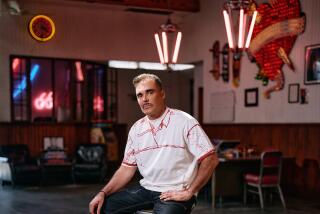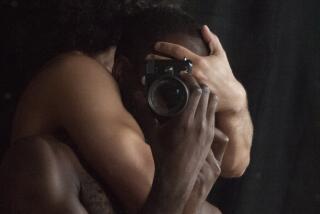STUDIO 54: The Legend.<i> Text by Anthony Haden-Guest</i> .<i> Concept and additional text by Anthony Haden-Guest</i> .<i> Photographs by Felice Quinto te Neues Publishing Co.: 126 pp., $29.95</i>
- Share via
“Studio 54: The Legend” is a modest-looking coffee table book, a commemorative album of snapshots taken at the legendary discotheque by someone named Quinto, a self-proclaimed paparazzo who, in the plummy days of La Dolce Vita, was once attacked by Anita Ekberg with a bow and arrow. Quinto’s photos are garnished by the (mercifully) brief recollections of Anthony Haden-Guest, three-year winner of Spy magazine’s Iron Man contest; Niels Kummer, a German journalist; and the aforementioned Quinto, who writes of himself in the third person, as in, “Felice Quinto, an immaculately tailored Roman,” “Quinto admitted that decorum must sometimes be abandoned,” “Not even Steve Rubell . . . was as relieved as Felice Quinto.”
Quinto’s mostly black and white photos look as if they were all taken on the same bleary night, or at most two nights, though they may very well document the entire 30-month life span of Studio 54. The particular moment of competitive hedonism the club incarnated was, for all but the privileged few, all the same night, with the same roster of celebrities celebrating themselves in increasingly desperate fashion: Liza, Halston, Bianca, Calvin and their pals seem to have spent every waking minute of those faraway days dreaming up costumes to wear to all tomorrow’s parties. Their attire and their evening antics would be duly reported next morning in Page Six of the New York Post, in Liz Smith’s column, et cetera, et cetera.
It may have been the best disco ever, the best party ever, but by the time Studio 54 opened, the truly cool people in Manhattan were hanging out at CBGB’s and the Mudd Club, allergic to disco and the kind of well-heeled celebrity Studio catered to. For the young and vital punks of the day, Studio was a place to score drugs, occasionally to witness a wildly orchestrated special event. The attraction was watching famous people act out their private pathology in public, as if they were impostors of themselves in Halloween masks: snorting poppers, attending to busboys in the balcony, frugging with Truman Capote. They were obviously having fun, but it looked at times as if the fun were a lot of work.
Andy Warhol’s diaries provide the best chronicle of Studio 54’s heyday. Warhol goes to the club every night, compulsively, and reveals that the eminences most identified with the place are enmeshed in intricate personal dramas that get ratcheted up on the dance floor or down in the VIP lounge, with help from various chemicals. There’s Halston, locked in an infernal sexual power struggle with his assistant-cum-lover, a larcenous exhibitionist named Victor Hugo. Bianca, stinging from her breakup with Mick, making an ever-larger spectacle of herself to prove that she commands attention without her ex. Tragic Liza turns up night after night to advertise her latest affair, as if living out the Cabaret lyric that “maybe this time” she’ll be happy. In Warhol’s diaries, the gaudy surfaces and frapped extras caught by Quinto’s camera fall away, revealing an astonishingly tedious “Days of Our Lives” sort of soap opera, involving at most nine or 10 people. Warhol shows us the empty, fraught evening hours before show time, Bianca flipping burgers at Halston’s house, the essential horror of it all. . . .
Then there’s Steve Rubell, co-owner and front man for the club, a tiny person in blue jeans who seems to be holding, in most of Quinto’s photos, the same open bottle of champagne, stoned on Quaaludes, apparently urging his favored patrons to ingest this and that, keeping the party going at all costs. Unlike his partner, Ian Schrager, who has long since become a successful hotelier, the late Rubell is somehow a tragic figure, a gay guy who figured out how to surround himself with wonderfully available, gorgeous young men and make money doing it. Studio 54 became the apotheosis of one kind of gay carnality, and it was Rubell’s genius to make entrance to his club the most rabidly sought leisure pursuit of straight people aspiring to hipness. Hubristically, Rubell neglected to pay his taxes, perhaps in the belief that Studio’s Angel of Darkness, Roy Cohn, could get him out of any jam.
Kummer notes that Rubell and Schrager, when sentenced to 3 1/2 years in prison for tax evasion, “agreed to inform on a couple of rival [club] owners . . . and were released after 13 months.” Rubell’s fuming snitch cast a very dark retroactive shadow over the epic saturnalia he’d so tirelessly engineered during what one writer called “the golden age of promiscuity.” It was too much the kind of thing Roy Cohn would have urged him to do. Something unsavory clung to him after his jail term, though the less ectoplasmic Schrager escaped this odium. Shortly after, the team launched The Palladium (as consultants). Rubell told a reporter, “Gay, it’s a lonely life.” While many took this as the homophobic remark of a closet case, I thought at the time that Rubell was talking about himself, about his own isolation, which was, sadly, deserved. A few years later he died of AIDS.
A reliable social history of ‘70s clubland remains to be written and perhaps never will be. It’s often said of the period: “If you can remember it, you weren’t there.” One does remember, though, as this book doesn’t, that there was more to Manhattan night life than disco, that other energies were releasing themselves or fermenting in less celebrated venues at the time and that the bacchanal of Studio 54, with its capricious door policy and predictable core of elephantine personalities, was more about defining who most people weren’t than about having a truly good time.
More to Read
The biggest entertainment stories
Get our big stories about Hollywood, film, television, music, arts, culture and more right in your inbox as soon as they publish.
You may occasionally receive promotional content from the Los Angeles Times.










